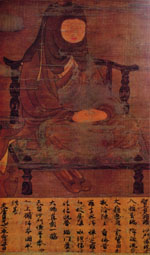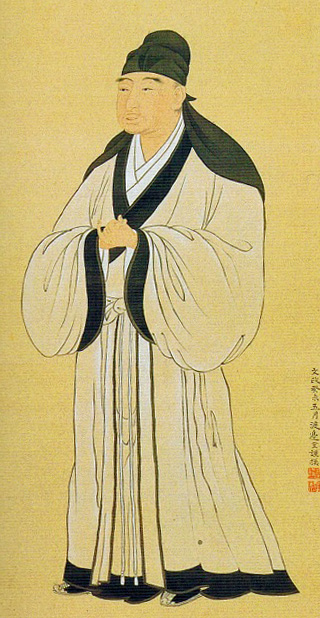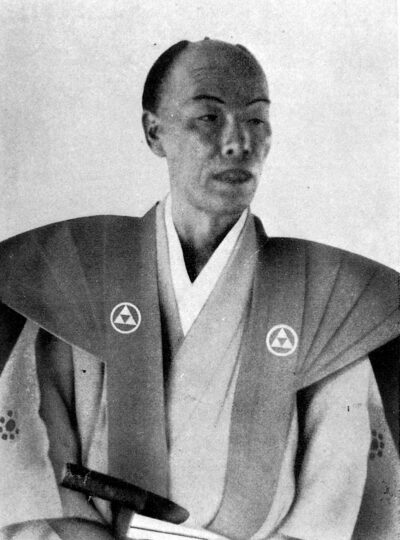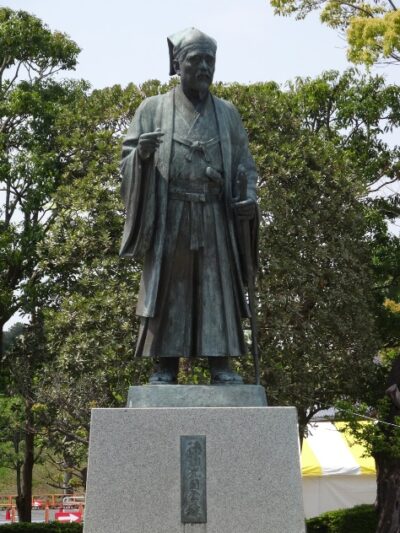智顗 天台宗の開祖 教相判釈と三大部 法華玄義 法華文句 摩訶止観

Zhiyi: Founder of the Tiantai School, Teaching, Interpretation, and the Three Major Sections: “Commentary on the Meaning of the Teachings,” “Mystical Meanings of the Lotus Sutra,” and “Verses on the Lotus Sutra,” along with “Mahāyāna Samādhi Sūtra.”
イントロダクション
智顗(ちぎ)は、中国南北朝時代の僧侶であり、天台宗の開祖として知られています。
彼の教えは、仏教の教義を体系的に整理し、多くの後世の仏教思想に影響を与えました。
智顗の思想の中核には、「教相判釈」という概念があります。
これは、仏教の経典や教義を分類し、理解しやすくするための方法論です。
智顗はこの方法を用いて、仏教の複雑な教えを整理し、一般の人々にも理解しやすい形で伝えました。
智顗の代表的な著作には、『法華玄義』『法華文句』『摩訶止観』の三大部があります。
これらの著作は、法華経の解釈と瞑想の実践について詳細に述べており、天台宗の教義の基盤を形成しています。
特に、『法華玄義』では、法華経の深い意味を解き明かし、『法華文句』ではその具体的な文句の解釈を行っています。
一方、『摩訶止観』は瞑想の実践方法について詳述しており、心の静寂と観察の技法を説いています。
智顗の教えは、仏教の教義を深く理解し、実践するための重要な指針となっています。
Introduction
Zhiyi, a monk from the period of the Southern and Northern Dynasties in China, is renowned as the founder of the Tiantai School.
His teachings systematically organized Buddhist doctrines, exerting a significant influence on later Buddhist thoughts.
At the core of Zhiyi’s philosophy lies the concept of “Teaching, Interpretation,” a methodology for categorizing and elucidating Buddhist scriptures and doctrines.
By employing this approach, Zhiyi organized the complex teachings of Buddhism and conveyed them in an understandable manner to the general populace.
Among Zhiyi’s notable works are the three major sections: “Commentary on the Meaning of the Teachings,” “Mystical Meanings of the Lotus Sutra,” and “Verses on the Lotus Sutra.”
These works extensively expound upon the interpretation of the Lotus Sutra and the practice of meditation, laying the foundation for the doctrines of the Tiantai School.
In particular, “Commentary on the Meaning of the Teachings” elucidates the profound significance of the Lotus Sutra, while “Mystical Meanings of the Lotus Sutra” provides interpretations of specific passages.
On the other hand, “Verses on the Lotus Sutra” details meditation practices, advocating for the tranquility of the mind and techniques for observation.
Zhiyi’s teachings serve as crucial guidelines for deeply understanding and practicing Buddhist doctrines.
智顗とは:生涯と業績
智顗(538年-597年)は、中国隋代の僧侶であり、「天台宗の開祖」として知られています。
彼の教えは仏教の中でも特に体系的であり、「五時八教の教相判釈」はその代表例です。
智顗は、仏教経典を五つの時期に分類し、八つの教えに分けて解説しました。
智顗の主要な著作には『法華玄義』『法華文句』『摩訶止観』があります。
『法華玄義』は法華経の教えを理論的に解釈し、『法華文句』は法華経の文句を詳細に解説しています。
『摩訶止観』は瞑想の実践方法を示した重要なテキストです。
智顗の生涯は、仏教の理論と実践の両面で大きな影響を与えました。
彼の教えは後に日本の天台宗にも伝わり、多くの僧侶に影響を与えました。
智顗の業績は、仏教の発展において欠かせないものとして評価されています。
智顗の生涯:生没年と重要な出来事
智顗(538年-597年)は、中国隋代の「天台宗の開祖」として知られる高僧です。
彼は「五時八教の教相判釈」を提唱し、仏教の教義を体系的に整理しました。
智顗の代表的な著作には『法華玄義』、『法華文句』、『摩訶止観』があります。
これらの著作を通じて、彼は法華経の教えを深く探求し、後世に大きな影響を与えました。
智顗の生涯における重要な出来事として、彼が天台山で修行を行ったことが挙げられます。
天台山での修行を通じて、彼は仏教の教義を深め、天台宗の基礎を築きました。
また、彼は隋の皇帝からも尊敬され、仏教界において高い評価を受けました。
智顗の思想と教えは、後の中国仏教のみならず、日本や韓国にも広がり、現在でも多くの僧侶や学者により研究されています。
彼の教えは、仏教の理解を深めるための重要な手がかりとなっています。
智顗の業績:天台宗開祖としての役割
智顗(538年-597年)は、中国南北朝時代の僧侶で、天台宗の開祖として知られています。
彼の業績は多岐にわたり、その中でも「五時八教の教相判釈」は特筆すべきです。
これは仏教経典を五つの時期に分け、八つの教えに分類する方法で、仏教理解の体系化に大きく寄与しました。
また、智顗は『法華玄義』や『法華文句』といった重要な著作を残しました。
これらの著作は『法華経』の深い解釈を提供し、後世の仏教学に多大な影響を与えました。
特に『摩訶止観』は、禅定と観法の実践を詳述したもので、天台宗の修行法の基盤となっています。
智顗の思想は、単なる理論にとどまらず、実践的な面でも重要です。
彼の教えは、中国のみならず、日本や韓国など東アジア全域に広まり、天台宗の発展に大きく貢献しました。
Zhiyi: Life and Accomplishments
Zhiyi (538-597) was a monk during China’s Sui Dynasty and is known as the founder of the Tiantai School.
His teachings in Buddhism were particularly systematic, with “The Classification of Teachings in Five Periods and Eight Teachings” being a notable example.
Zhiyi categorized Buddhist scriptures into five periods and explained them through eight teachings.
Among Zhiyi’s major works are the “Mystical Meanings of the Lotus Sutra,” “Verses on the Lotus Sutra,” and “Great Calming and Contemplation.”
The “Mystical Meanings of the Lotus Sutra” interprets the theoretical aspects of the Lotus Sutra, while the “Verses on the Lotus Sutra” provides a detailed explanation of its verses.
On the other hand, the “Great Calming and Contemplation” outlines essential meditation practices.
Zhiyi’s life profoundly influenced both the theoretical and practical aspects of Buddhism.
His teachings later spread to Japan’s Tendai School, influencing many monks.
Zhiyi’s contributions are highly regarded for their significance in the development of Buddhism.
Zhiyi’s Life: Birth and Death Years and Key Events
Zhiyi (538-597) was a prominent monk known as the “founder of the Tiantai School” during China’s Sui Dynasty.
He advocated “The Classification of Teachings in Five Periods and Eight Teachings,” systematically organizing Buddhist doctrines.
Zhiyi’s notable works include “Mystical Meanings of the Lotus Sutra,” “Verses on the Lotus Sutra,” and “Great Calming and Contemplation.”
Through these works, he delved deeply into the teachings of the Lotus Sutra, exerting a significant influence on future generations.
An essential event in Zhiyi’s life was his meditation practice on Mount Tiantai.
Through this practice, he deepened his understanding of Buddhist doctrines and laid the foundation for the Tiantai School.
Moreover, he earned respect from the Sui Emperor and high esteem within the Buddhist community.
Zhiyi’s philosophies and teachings spread not only throughout China but also to Japan and Korea, where they continue to be studied by monks and scholars today.
His teachings serve as vital clues for deepening the understanding of Buddhism.
Zhiyi’s Achievements: Role as the Founder of the Tiantai School
Zhiyi (538-597) was a monk during China’s Southern and Northern Dynasties period, renowned as the founder of the Tiantai School.
His achievements were diverse, with “The Classification of Teachings in Five Periods and Eight Teachings” being particularly notable.
This method of categorizing Buddhist scriptures into five periods and eight teachings significantly contributed to the systemization of Buddhist understanding.
Additionally, Zhiyi left behind important works such as “Mystical Meanings of the Lotus Sutra” and “Verses on the Lotus Sutra.”
These works provided profound interpretations of the Lotus Sutra, greatly influencing Buddhist studies in later generations.
Especially, “Great Calming and Contemplation” detailed meditation and contemplation practices, forming the foundation of Tiantai School’s meditation methods.
Zhiyi’s philosophy transcended mere theory, also offering practical guidance.
His teachings spread not only in China but also throughout East Asia, including Japan and Korea, contributing significantly to the development of the Tiantai School.
天台宗の理論:智顗の教え
天台宗の理論において、智顗(ちぎ)は重要な存在です。
彼は538年に中国で生まれ、天台宗を開祖しました。
智顗の教えは「五時八教の教相判釈」によって体系化されており、これは仏教の教えを五つの時期と八つの教えに分類するものです。
特に『法華玄義』、『法華文句』、『摩訶止観』という三大著作は、彼の思想を深く理解するための重要な文献です。
『法華玄義』は法華経の深い意味を解説し、『法華文句』は具体的な文句の解釈を提供します。
『摩訶止観』では、瞑想の技法と理論が詳述されており、これらの著作を通じて智顗の教えが体系的に伝えられています。
彼の理論は、日本の天台宗にも大きな影響を与え、最澄によって日本に伝えられました。
智顗の教えは、仏教の理論と実践を統合するものであり、彼の著作を通じてその深遠な思想に触れることができます。
五時八教の教相判釈:智顗の教義解釈
智顗(538年-597年)は「天台宗の開祖」として知られ、その教義解釈は仏教史においても重要な位置を占める。
彼の代表的な教義解釈の一つが「五時八教の教相判釈」である。
これは、仏教の教えを時間の経過に従って五つの時期に分け、八つの教えに分類する方法論だ。
智顗はこの体系を通じて、仏陀の教えがどのように発展し、深化していくかを示した。
『法華玄義』、『法華文句』、『摩訶止観』といった著作を通じて、智顗の教義解釈は具体化された。
特に『法華玄義』では、法華経の深遠な意味を解説し、その重要性を強調している。
また、『摩訶止観』では、瞑想と実践の方法を詳細に述べており、仏教の実践面にも大きな影響を与えた。
智顗の教義解釈は、単なる理論にとどまらず、実践を通じて真理に到達する道を示している。
このような包括的な教義体系は、後の仏教思想にも大きな影響を与え続けている。
法華玄義と法華文句:智顗の法華経解釈
智顗(ちぎ)は、中国の隋代に活躍し、「天台宗の開祖」として知られています。
彼の法華経解釈は、特に『法華玄義』と『法華文句』という二つの著作において詳述されています。
『法華玄義』は法華経の深遠な意味を解き明かし、『法華文句』は具体的な文句に注釈を加えたものです。
智顗は「五時八教の教相判釈」という独自の教理体系を構築しました。
これにより、仏教経典を五つの時期に分類し、それぞれの教えを八つの教えに分けることで、仏教の全体像を整理しました。
この教相判釈は、後の仏教思想に大きな影響を与えました。
また、智顗のもう一つの重要な著作『摩訶止観』は、瞑想法や修行法についての詳細な解説が含まれています。
これらの著作を通じて、智顗は法華経の教えを深く理解し、広めることに成功しました。
彼の思想は、後の仏教発展においても重要な役割を果たしています。
Tiantai School Theory: Teachings of Zhiyi
Zhiyi (538-597) is a significant figure in the theory of the Tiantai School.
Born in 538 in China, he founded the Tiantai School.
Zhiyi’s teachings are systematized by the concept of “The Classification of Teachings in Five Periods and Eight Teachings,” which categorizes Buddhist teachings into five periods and eight doctrines.
Especially, his three major works, “Mystical Meanings of the Lotus Sutra,” “Verses on the Lotus Sutra,” and “Great Calming and Contemplation,” are crucial texts for understanding his philosophy.
“The Mystical Meanings of the Lotus Sutra” explains the profound meanings of the Lotus Sutra, while “Verses on the Lotus Sutra” offers interpretations of specific verses.
On the other hand, “Great Calming and Contemplation” elaborates on meditation techniques and theories, systematically transmitting Zhiyi’s teachings.
His theories had a significant impact on Japan’s Tendai School, transmitted to Japan by Saicho.
Zhiyi’s teachings integrate both the theory and practice of Buddhism, allowing access to his profound thoughts through his writings.
Classification of Teachings in Five Periods and Eight Teachings: Zhiyi’s Interpretation of Doctrine
Zhiyi (538-597) is renowned as the “founder of the Tiantai School,” with his doctrinal interpretations holding a crucial place in Buddhist history.
One of his notable doctrinal interpretations is “The Classification of Teachings in Five Periods and Eight Teachings.”
This methodology categorizes Buddhist teachings into five periods based on the progression of time, dividing them into eight doctrines.
Through this system, Zhiyi illustrated how Buddha’s teachings evolved and deepened over time.
His doctrinal interpretations were concretized through works like “Mystical Meanings of the Lotus Sutra,” “Verses on the Lotus Sutra,” and “Great Calming and Contemplation.”
Especially in “Mystical Meanings of the Lotus Sutra,” he expounds upon the profound meanings of the Lotus Sutra, emphasizing its significance.
Moreover, “Great Calming and Contemplation” provides detailed descriptions of meditation and practice methods, significantly influencing the practical aspect of Buddhism.
Zhiyi’s doctrinal interpretations not only remained theoretical but also paved the way to attain truth through practice.
Such a comprehensive doctrinal system continued to exert a significant influence on later Buddhist thoughts.
Mystical Meanings of the Lotus Sutra and Verses on the Lotus Sutra: Zhiyi’s Interpretation of the Lotus Sutra
Zhiyi (538-597) was active during China’s Sui Dynasty and is known as the “founder of the Tiantai School.”
His interpretations of the Lotus Sutra are particularly detailed in two works: “Mystical Meanings of the Lotus Sutra” and “Verses on the Lotus Sutra.”
“Mystical Meanings of the Lotus Sutra” elucidates the profound meanings of the Lotus Sutra, while “Verses on the Lotus Sutra” provides annotations on specific passages.
Zhiyi constructed his unique doctrinal system called “The Classification of Teachings in Five Periods and Eight Teachings.”
This system organized Buddhist scriptures into five periods and divided each teaching into eight doctrines, thereby organizing the entirety of Buddhist teachings.
This doctrinal classification significantly influenced later Buddhist thought.
Additionally, another crucial work by Zhiyi, “Great Calming and Contemplation,” contains detailed explanations of meditation and practice methods.
Through these works, Zhiyi deeply understood and successfully disseminated the teachings of the Lotus Sutra.
His philosophies played a vital role in the subsequent development of Buddhism.
智顗の瞑想法:摩訶止観
智顗は、中国の隋代に活躍した「天台宗の開祖」であり、その瞑想法である『摩訶止観』は、仏教の修行法として広く知られています。
『摩訶止観』は、智顗が566年から567年にかけて書いたもので、仏教の深遠な教えを実践的に解説しています。
この瞑想法は、「止」と「観」の二つの要素から成り立ち、心を静める「止」と、真理を観察する「観」を組み合わせたものです。
智顗はまた、仏教教義の体系化にも尽力しました。
彼の著作『法華玄義』や『法華文句』は、「法華経」の教えを詳細に解説したものであり、特に五時八教の教相判釈は、仏教の発展段階を五つの時期に分け、八つの教えに分類する方法論です。
これにより、仏教の複雑な教義を理解しやすくしました。
このように、智顗の教えと「摩訶止観」は、天台宗のみならず、広く仏教全体に影響を与え続けています。
摩訶止観の概要:智顗が提唱した瞑想法
智顗(ちぎ)は、6世紀の中国で天台宗を開いた僧侶であり、彼の提唱した『摩訶止観』は、仏教瞑想法の一つとして知られています。
『摩訶止観』、文字通り「止」と「観」を組み合わせたもので、心を静める「止」と、物事の真理を観察する「観」の二つの要素から成り立っています。
智顗はこの瞑想法を通じて、悟りに至る道を示しました。
智顗が著した『摩訶止観』は、天台宗の教義を理解する上で重要なテキストです。
彼はまた、『法華玄義』や『法華文句』といった著作も残しており、これらは五時八教の教相判釈を基にした教義の解説書です。
智顗の教えは、特に法華経を中心に展開され、彼の影響は後の中国仏教のみならず、日本の仏教にも大きな影響を与えました。
摩訶止観の実践は、日常生活の中で心の平静を保ち、深い洞察を得るための方法として現代でも注目されています。
摩訶止観の実践:その方法と意義
『摩訶止観』は、中国の「智顗」によって体系化された瞑想法で、天台宗の開祖として知られる彼の教えの一環です。
この瞑想法は、心を静める「止」と、物事の本質を観察する「観」の二つの要素から成り立ちます。
智顗は『法華玄義』『法華文句』『摩訶止観』などの著作を通じて、「五時八教の教相判釈」を行い、仏教の教えを整理しました。
摩訶止観の実践方法としては、まず「止」によって心を安定させ、その後「観」によって物事の真理を見極めることが求められます。
このプロセスは、日常生活の中での心の平穏や、深い理解を促進します。
特に『摩訶止観』では、具体的な瞑想のステップが詳細に記されています。
この瞑想法の意義は、個々の心の浄化と、より広い視点からの悟りにあります。
天台宗の教えに基づき、摩訶止観は現代でも多くの人々に実践されています。
Zhiyi’s Meditation Method: Mohe Zhiguan
Zhiyi, the founder of the Tiantai School during China’s Sui Dynasty, is widely known for his meditation method called “Mohe Zhiguan,” which has gained recognition as a Buddhist practice.
“Mohe Zhiguan,” written by Zhiyi between 566 and 567, explains the profound teachings of Buddhism in a practical manner.
This meditation method consists of two elements: “Zhì” (cessation) and “Guān” (observation), combining the calming of the mind with the observation of truth.
Zhiyi also contributed to the systematization of Buddhist doctrines.
His works like “Mystical Meanings of the Lotus Sutra” and “Verses on the Lotus Sutra” provide detailed explanations of the teachings of the Lotus Sutra.
Especially, the concept of “The Classification of Teachings in Five Periods and Eight Teachings” categorizes Buddhism’s developmental stages into five periods and eight doctrines, simplifying the complex Buddhist doctrines for better understanding.
Thus, Zhiyi’s teachings, along with “Mohe Zhiguan,” continue to influence not only the Tiantai School but also Buddhism as a whole.
Overview of Mohe Zhiguan: Zhiyi’s Proposed Meditation Method
Zhiyi, an influential monk who founded the Tiantai School in 6th-century China, introduced the meditation method known as “Mohe Zhiguan,” a significant part of his teachings.
“Mohe Zhiguan,” literally combining “cessation” and “observation,” comprises two aspects: calming the mind and observing the essence of things.
Through this meditation method, Zhiyi pointed the way to enlightenment.
His work “Mohe Zhiguan” is a vital text for understanding the doctrines of the Tiantai School.
He also left behind works like “Mystical Meanings of the Lotus Sutra” and “Verses on the Lotus Sutra,” which explain Buddhist doctrines based on “The Classification of Teachings in Five Periods and Eight Teachings.”
Zhiyi’s teachings, particularly centered around the Lotus Sutra, influenced not only later Chinese Buddhism but also had a significant impact on Japanese Buddhism.
The practice of Mohe Zhiguan aims to maintain inner peace in daily life and gain profound insights, making it relevant in contemporary times.
Practice of Mohe Zhiguan: Its Method and Significance
“Mohe Zhiguan” is a meditation method systematized by Zhiyi, a Chinese monk known as the founder of the Tiantai School.
This meditation method comprises two elements: “cessation” and “observation,” as outlined in Zhiyi’s teachings.
Through works like “Mystical Meanings of the Lotus Sutra,” “Verses on the Lotus Sutra,” and “Mohe Zhiguan,” Zhiyi elucidated the doctrines based on “The Classification of Teachings in Five Periods and Eight Teachings,” organizing Buddhist teachings.
In the practice of Mohe Zhiguan, one stabilizes the mind through “cessation” and then discerns the truth of things through “observation.”
This process promotes inner peace in daily life and facilitates deep understanding.
Especially in “Mohe Zhiguan,” specific steps for meditation are detailed.
The significance of this meditation method lies in purifying individual minds and attaining enlightenment from a broader perspective.
Based on the teachings of the Tiantai School, Mohe Zhiguan continues to be practiced by many in contemporary times.
智顗と天台宗の影響
智顗(538年-597年)は、中国仏教の天台宗の開祖として知られています。
彼は「五時八教の教相判釈」という教学体系を確立し、仏教経典の解釈に大きな影響を与えました。
特に『法華玄義』『法華文句』『摩訶止観』の三大著作は、天台宗の教義の基礎を築きました。
智顗の思想は、法華経を中心に据え、仏教全体を体系的に理解する方法を提供しました。
智顗の教えは、奈良時代に日本に伝わり、最澄によって広められました。
最澄は比叡山延暦寺を建立し、天台宗を日本の仏教の一大潮流に育て上げました。
これにより、智顗の思想は日本仏教にも深く根付くこととなりました。
智顗の影響は、中国や日本だけでなく、韓国やベトナムにも及び、東アジア全体の仏教思想に大きな影響を与えました。
彼の教義は、仏教の深遠な哲学的探求を促進し、多くの僧侶や学者にインスピレーションを与え続けています。
仏教に対する影響:天台宗の立ち位置
天台宗は6世紀に中国の「智顗」によって開かれた仏教の一派である。
智顗は「天台宗の開祖」として知られ、彼の教えは後の仏教に大きな影響を与えた。
特に「五時八教の教相判釈」は、仏教経典の解釈を体系化する重要な方法論として評価されている。
この教相判釈は、仏教の教えを五つの時期に分け、八つの教えに分類するもので、仏教の理解を深めるための重要な枠組みとなっている。
また、智顗の著作である『法華玄義』、『法華文句』、『摩訶止観』は、天台宗の教義を支える柱である。
法華玄義は法華経の深遠な意味を解説し、法華文句は法華経の各章句を詳述したものである。
『摩訶止観』は瞑想の方法を体系的に説明し、実践のガイドとして広く用いられている。
天台宗は、こうした教義と実践を通じて、仏教全体に深い影響を及ぼし続けている。
世界に対する影響:智顗と天台宗の現代への意義
智顗(538年 – 597年)は中国隋代の僧侶で、天台宗の開祖として知られています。
彼の「五時八教の教相判釈」は仏教の教義を整理し、理解を深めるための枠組みとして重要な役割を果たしました。
特に『法華玄義』や『法華文句』、『摩訶止観』といった著作は、仏教思想の深化に大きく寄与しました。
現代においても、智顗の思想は多くの人々に影響を与え続けています。
例えば、彼の『摩訶止観』は瞑想の実践方法として広く受け入れられ、精神的な安定や自己成長を目指す人々にとって重要な指針となっています。
さらに、智顗の教えは日本の仏教にも大きな影響を与えました。
平安時代に最澄が天台宗を日本に伝え、その後の日本仏教の発展に寄与しました。
智顗の教えは、現代の宗教研究や精神的な探求においても、依然として重要な位置を占めています。
The Influence of Zhiyi and the Tiantai School
Zhiyi (538-597) is renowned as the founder of the Tiantai School of Chinese Buddhism.
He established the doctrinal system of “The Classification of Teachings in Five Periods and Eight Teachings,” which greatly influenced the interpretation of Buddhist scriptures.
In particular, his three major works, “Mystical Meanings of the Lotus Sutra,” “Verses on the Lotus Sutra,” and “Mohe Zhiguan,” laid the foundation of Tiantai doctrine.
Zhiyi’s philosophy, centered around the Lotus Sutra, provided a systematic way to understand Buddhism as a whole.
His teachings spread to Japan during the Nara period and were propagated by Saicho.
Saicho established the Enryakuji Temple on Mount Hiei, nurturing the Tiantai School as a major branch of Japanese Buddhism.
As a result, Zhiyi’s ideology became deeply rooted in Japanese Buddhism.
Zhiyi’s influence extended not only to China and Japan but also to Korea and Vietnam, significantly shaping Buddhist thought across East Asia.
His doctrines continue to stimulate profound philosophical inquiries in Buddhism, inspiring many monks and scholars.
Impact on Buddhism: Position of the Tiantai School
The Tiantai School, founded by Zhiyi in 6th-century China, had a significant influence on later Buddhism.
Zhiyi, known as the founder of the Tiantai School, introduced the concept of “The Classification of Teachings in Five Periods and Eight Teachings,” which is highly regarded as a crucial method for interpreting Buddhist scriptures.
This classification system divides Buddhist teachings into five periods and eight doctrines, providing a vital framework for deepening the understanding of Buddhism.
Additionally, Zhiyi’s works such as “Mystical Meanings of the Lotus Sutra,” “Verses on the Lotus Sutra,” and “Mohe Zhiguan” form the pillars supporting the doctrines of the Tiantai School.
“Mystical Meanings of the Lotus Sutra” explains the profound meanings of the Lotus Sutra, while “Verses on the Lotus Sutra” provides detailed explanations of each chapter and verse of the Lotus Sutra.
“Mohe Zhiguan” systematically explains meditation methods and serves as a widely used guide for practice.
Through such doctrines and practices, the Tiantai School continues to have a profound influence on Buddhism as a whole.
Global Impact: Significance of Zhiyi and the Tiantai School in Modern Times
Zhiyi (538-597) was a Chinese monk during the Sui Dynasty, renowned as the founder of the Tiantai School.
His “The Classification of Teachings in Five Periods and Eight Teachings” played a crucial role in organizing and deepening the understanding of Buddhist doctrines.
Particularly, works like “Mystical Meanings of the Lotus Sutra,” “Verses on the Lotus Sutra,” and “Mohe Zhiguan” significantly contributed to the advancement of Buddhist thought.
Even in modern times, Zhiyi’s philosophy continues to influence many people.
For instance, his “Mohe Zhiguan” is widely accepted as a meditation practice method, serving as an essential guide for those seeking spiritual stability and personal growth.
Furthermore, Zhiyi’s teachings had a significant impact on Japanese Buddhism.
During the Heian period, Saicho introduced the Tiantai School to Japan, contributing to the development of Japanese Buddhism.
Zhiyi’s teachings still hold a crucial position in contemporary religious studies and spiritual inquiries.
関連語をあわせて調べる
「智顗」は、中国の南北朝時代に活躍した僧であり、「天台宗の開祖」として知られています。
彼の思想は「五時八教の教相判釈」という独自の教理体系に基づいています。
この教理体系は、仏教経典を五つの時期に分類し、それぞれに適した教えを説くものです。
智顗の代表的な著作には『法華玄義』『法華文句』そして『摩訶止観』があります。
『法華玄義』は法華経の深い意味を解説したもので、『法華文句』は法華経の文言に注目して解釈を行っています。
『摩訶止観』は瞑想法に関する詳細な指導書であり、実践的な面でも非常に重要な位置を占めています。
智顗の教えは、中国だけでなく、日本にも大きな影響を与えました。
特に平安時代の日本では、天台宗が国家的な宗教として広まり、多くの僧侶が智顗の著作を学びました。
彼の思想は、現代においても多くの仏教研究者によって研究されています。
Exploring Related Terms: Zhiyi and His Influence
Zhiyi was a prominent monk who flourished during China’s Southern and Northern Dynasties period, known as the founder of the Tiantai School.
His ideology is based on a unique doctrinal system called “The Classification of Teachings in Five Periods and Eight Teachings.”
This system categorizes Buddhist scriptures into five periods and elucidates appropriate teachings for each.
Zhiyi’s major works include “Mystical Meanings of the Lotus Sutra,” “Verses on the Lotus Sutra,” and “Mohe Zhiguan.”
“Mystical Meanings of the Lotus Sutra” elucidates the profound meanings of the Lotus Sutra, while “Verses on the Lotus Sutra” focuses on interpreting the text of the Lotus Sutra.
“Mohe Zhiguan” serves as a detailed guidebook on meditation practices and holds a significant practical importance.
Zhiyi’s teachings exerted a considerable influence not only in China but also in Japan.
Especially during Japan’s Heian period, the Tiantai School spread as a state religion, and many monks studied Zhiyi’s works.
His ideology continues to be studied by numerous Buddhist scholars even in modern times.



Warning: Undefined variable $comment_form_sns_tags in /home/ktsky/philosophy-kayak.com/public_html/wp-content/themes/shaper/comments.php on line 27